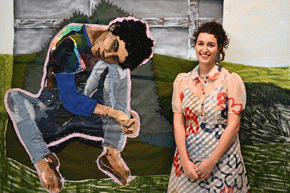Something completely different: a music review by Fraser Beath McEwing
Although Geoffrey Lancaster is a world-renowned performer on the fortepiano, it was risky to devote one of the four piano series recitals to a period instrument.

Geoffrey Lancaster
Added to that was the gamble that audiences would take to a whole night of Mozart. It was not surprising, therefore, that the Sydney City Recital Hall was sparsely populated at the beginning of this concert, and even less so after interval when it became apparent that a percentage of the starters had legged it into the night.
That was the negative side. The positive was that we were treated to hearing the type of piano that Mozart, Haydn and Beethoven used for composition and performance. Not only that but played by fortepiano royalty. Geoffrey Lancaster currently lives in Perth where he is a professor at the Western Australian Academy of Performing Arts, Edith Cowan University. He has an impressive history of highly placed academic appointments and performances behind him, to say nothing of his contribution to Australian music that brought him an AO in 2006. And he loves old keyboard instruments, having saved many from becoming kindling.
The fortepiano is the father of today’s grand piano. While it is a similar length, it is considerably skinnier (a keyboard of only five octaves) and far lighter than a concert grand because it has no iron frame – only wood. It stands on five spindly legs and its keys are white and black rather than black and white. Its doe-leather covered hammers and light action make it more sensitive under the fingers than modern pianos. Rather than sustaining and damper pedals, most examples have two levers under the keyboard worked by the knees. To the uninitiated, it can sound like granny’s old upright that needs work.
Fortepianos were the favoured keyboard instrument between the late-18thto early-19thcentury when technology began pushing towards the current grand piano. Nevertheless, there are still a lot of fortepianos in use and even new ones being made for people who love that frail, nostalgic sound and are part of the growing enthusiasm for period instruments. Forepianos almost demand that only music from their era be played on them. Forget Liszt or Rachmaninov, both in the interests of the composers and the survival of the fortepiano.
Lancaster chose three Mozart sonatas and a rondo for his program. All the works are quite beguiling, especially if you close your eyes and imagine Mozart sitting at the keyboard instead of the more substantial Lancaster. But you had to listen very carefully to pick up all the notes, even though the fortepiano was placed right at the back of the stage to take advantage of sound reflection off the wall. Anything pianissimo was barely audible while the bass did a lot of muffled buzzing but not much projection.
Lancaster used sheet music and a page-turner for all his pieces. Maybe that was recalling a tradition of the fortepiano era, as was his preluding before the beginning of each work.

Fraser Beath McEwingn nn
The three Mozart sonatas he chose were K.570, K.282 and K.333. The rondo was K.511. Lancaster’s clear, even technique was especially suited to Mozart with his playing of the ornaments in a class of its own.
I’d expected a precise, even clinical interpretation of Mozart, especially on a period instrument in the hands of an authority and master technician. But how wrong I was. Geoffrey Lancaster is one of the most romantic interpreters I’ve heard. This created a dichotomy. While I might have put it down to an unfamiliar instrument, the pauses, rubato and fade-out phrasing were as unexpected as they were unmistakable. His playing of the Rondo made it sound like Chopin. Mozart purists might have taken exception to it, but I heard it as wonderfully seductive playing – to even better effect in a salon rather than a cavernous concert hall.
The proof of the pudding came right at the end when Lancaster’s final encore was the piece we all learned as kids: Beethoven’s Fur Elise, offered, Lancaster told his audience, in honour of Beethoven’s 250thbirthday next year. The interpretation broke all the rules and was simply exquisite.
Sydney City Recital Hall 2 September 2019







